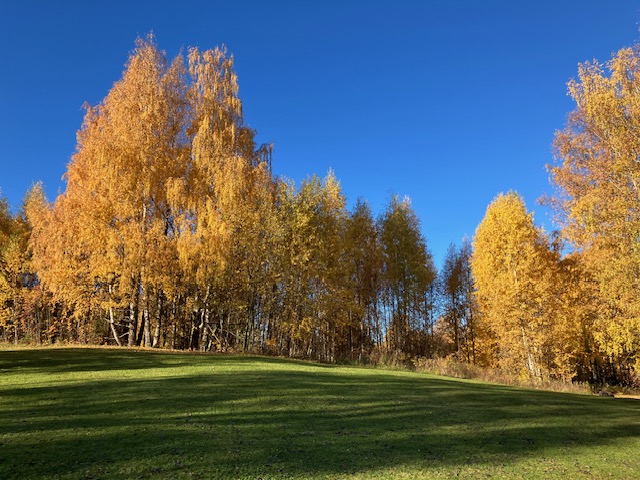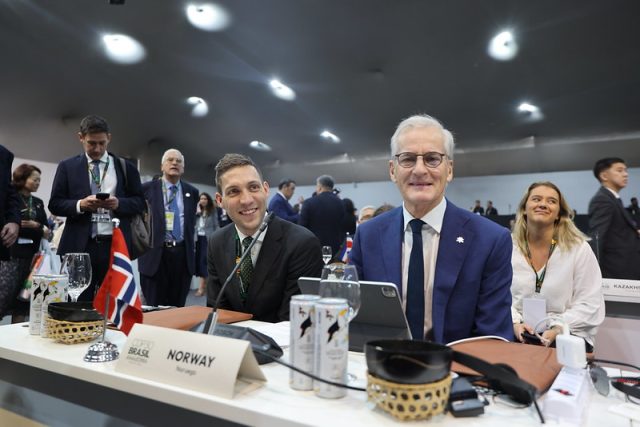It’s been an unusually warm autumn in most of Norway this year, with temperatures averaging 5C over “normal” levels and fueling a sense of urgency at the current UN Climate Summit in Brazil. Norwegian government officials are taking part as usual and offering more funding for climate measures, just as winter is about to finally set in.
 Fall colours came late this year in Norway because of unusually warm weather that kept lawns green and flowers blooming until early November. These were recently on display in Hamar, northeast of Oslo, but now snow may start falling in Southern Norway. PHOTO: NewsinEnglish.no/Nina Berglund
Fall colours came late this year in Norway because of unusually warm weather that kept lawns green and flowers blooming until early November. These were recently on display in Hamar, northeast of Oslo, but now snow may start falling in Southern Norway. PHOTO: NewsinEnglish.no/Nina Berglund
State meteorologists were predicting an abrupt change in the weather later this week. Temperatures are due to dive and the first snow at low elevations may start falling in Southern Norway. There’s already been some snow in Northern Norway, but it came late this year, too.
While Norwegians braced not only for snow but also strong winds to be followed by cold sunny weather this weekend, Norwegian Prime Minister Jonas Gahr Støre was in hot and humid Brazil at the latest UN Climate Summit. He and Andreas Bjelland Eriksen, his government minister in charge of climate and the environment, want to remain one of the world’s largest supporters of rain forests that help absorb carbon emissions. They pledged up to NOK 30 billion (USD 3 billion) over 10 years to a new international fund to help secure rain forests for generations to come.
“It’s vital to stop deforestation to reduce the impacts of climate change and limit biodiversity loss,” Støre said during the unveiling of what’s called the Tropical Forest Forever Facility (TFFF). The project has been promoted by Brazil’s President Luiz Inacio Lula da Silva, and Norway’s funding contribution will provide low-interest loans to tropical forest protection projects that Norway will guarantee. Newspaper Aftenposten reports that Norwegian officials have assessed the risks of repayment and are budgeting to allocate NOK 3 billion per year with the hope that at least NOK 1.5 billion will be repaid.
 Norwegian Prime Minister Jonas Gahr Støre (right) talking with Brazil’s President Luiz Inacio Lula da Silva at this year’s Climate Change Conference (COP30) in Belém in the Brazilian Amazon. PHOTO: Martin Lerberg Fossum / Statsministerens kontor
Norwegian Prime Minister Jonas Gahr Støre (right) talking with Brazil’s President Luiz Inacio Lula da Silva at this year’s Climate Change Conference (COP30) in Belém in the Brazilian Amazon. PHOTO: Martin Lerberg Fossum / Statsministerens kontor
Norway will also demand that other countries contribute at least NOK 100 billion during the course of next year, so that Norway can limit its contribution to no more than 20 percent of the total. Brazil and Indonesia, where Norway also has been active in protecting rain forests, have announced contributions of USD 1 billion each while Støre also still needs approval for the project in Parliament.
It’s all another example of how Norway pays other countries to reduce emissions after years of promises to reduce its own as well. Emissions actually have fallen in Norway, and there are signs that Norway’s oil era is beginning to wind down, but not by enough in either case. Støre’s government also announced new climate goals just before the climate conference in Brazil began, including emission cuts of at least 70 percent by 2035.
That was even higher than the EU’s new goal of 66.3 percent, and it sparked debate in Parliament, with Støre’s former government partner calling it “a scandal for Norwegian interests.” It can mean higher fees and more restrictions but mostly more ambitious climate measures, and they’re not as politically difficult to achieve after all the recent and disturbing evidence of climate change in Norway itself. Norwegians already have made a massive shift from fossil-fueled vehicles to electric, recycling has soared and so have carbon capture projects. Criticism continues, though, because of the country’s oil and gas industry.
 Climate Minister Andreas Bjelland Eriksen (left) and Prime Minister Jonas Gahr Støre at the climate conference in Brazil. PHOTO: Martin Lerberg Fossum / Statsministerens kontor
Climate Minister Andreas Bjelland Eriksen (left) and Prime Minister Jonas Gahr Støre at the climate conference in Brazil. PHOTO: Martin Lerberg Fossum / Statsministerens kontor
It’s Norway’s wealth from oil and gas production for nearly 60 years that’s being tapped to fund climate projects. Another one unveiled in Brazil is an effort to provide more money (now from the TFFF) and political support for indigenous populations so they can protect their own tropical forests in Brazil, Peru and elsewhere. Recipients called the project “an historic victory that recognizes our leadership in the fight against climate change.” Juan Carlos Jintiach of the Global Alliance of Territorial Communities called it “not only a matter of justice, but a strategy to save the planet.”
Eriksen agreed: “Strengthening indigenous rights is one of the most effective measures to reduce deforestation,” he said. “This is both about social justice and about protecting forests that absorb and store carbon.” Norway, Germany, the UK and 35 philantropic foundations are jointly committing USD 1.8 billion to be disbursed by the end of 2030. Various efforts so far have led to Brazil’s recognition of 13 new indigenous terrorities while Colombia has allocated 160,000 square kilometers of forested lands for indigenous municipalities. Indonesia has also boosted forest management programs with its indigenous communities in an area of 83,000 square kilometers.
“The world must increase the tempo of climate work if we’re to meet the goals of the Paris Agreement,” Støre said before leaving for Brazil. “Norway will be a clear voice for higher ambitions, more activity and concrete results.”
NewsinEnglish.no/Nina Berglund